Are your students disengaged in the classroom? Do you find it challenging to capture and maintain their attention? You’re not alone. Many educators struggle with student engagement, which can hinder learning outcomes. However, there are strategies you can implement to increase student engagement and create a more interactive and inclusive learning environment.
In this article, we will explore ten effective strategies to boost student engagement in the classroom. From incorporating technology and gamification to promoting active learning and fostering a positive classroom culture, these evidence-based techniques will help you create a stimulating and motivating educational experience.
Engaged students are more likely to participate, retain information, and develop critical thinking and problem-solving skills. By implementing these strategies, you can cultivate a classroom environment where students are excited to learn, collaborate, and actively participate in their own education.
So, if you’re ready to transform your classroom and make learning a dynamic and enjoyable experience for your students, let’s dive into these ten strategies to increase student engagement.
The importance of student engagement in the classroom

Student engagement is a critical component of effective teaching and learning. When students are engaged, they are more likely to actively participate in the learning process, retain information, and develop essential skills. Engaged students are curious, motivated, and invested in their own education.
Disengaged students, on the other hand, often struggle to stay focused, exhibit behavioral issues, and fail to achieve their full academic potential. Lack of engagement can lead to poor academic performance, increased absenteeism, and higher dropout rates. As educators, it is our responsibility to create learning environments that foster student engagement and support their overall success.
By implementing strategies to increase student engagement, educators can positively impact student outcomes, including improved academic achievement, enhanced critical thinking and problem-solving skills, and the development of lifelong learning habits. Engaged students are more likely to develop a deeper understanding of the subject matter, make meaningful connections to their own lives, and become active participants in their own education. Ultimately, fostering student engagement is a key to unlocking their full potential and preparing them for future success.
Understanding the factors that affect student engagement
Numerous factors can influence student engagement in the classroom. Understanding these factors is crucial for developing effective strategies to increase engagement. Some of the key factors that affect student engagement include:
- Instructional methods and teaching styles: The way in which content is delivered and the level of interactivity in the classroom can have a significant impact on student engagement. Passive, lecture-based instruction is often less engaging than active learning techniques that encourage student participation and collaboration.
- Classroom environment and culture: The physical and emotional climate of the classroom can greatly impact student engagement. A positive, welcoming, and inclusive environment that promotes a sense of belonging and safety is more likely to foster engaged learners.
- Student motivation and interests: Students’ intrinsic motivation, personal interests, and perceived relevance of the content can all influence their level of engagement. Connecting the curriculum to students’ lives and interests can increase their investment in the learning process.
- Student-teacher relationships: The quality of the relationship between students and their teacher can significantly impact engagement. When students feel supported, respected, and valued by their teacher, they are more likely to be engaged in the learning process.
- Classroom management and structure: Effective classroom management strategies, clear expectations, and a well-structured learning environment can help minimize distractions and promote engaged learning.
By understanding these factors, educators can develop targeted strategies to address the specific needs and challenges of their students, creating a more engaging and effective learning experience.
Creating a positive classroom environment

Establishing a positive and inclusive classroom environment is a fundamental step in fostering student engagement. When students feel safe, respected, and valued, they are more likely to participate actively and take risks in their learning. Begin by setting clear expectations and establishing a set of classroom norms and procedures that promote respect, collaboration, and open communication. Encourage students to contribute to the development of these guidelines, as this can increase their investment in following them.
Cultivate a warm and welcoming atmosphere by greeting students at the door, learning their names, and showing genuine interest in their lives and experiences. Celebrate diversity and foster a sense of community by incorporating inclusive practices, such as acknowledging different cultural backgrounds and perspectives.
Encourage a growth mindset in your students by emphasizing the importance of effort, persistence, and learning from mistakes. Provide opportunities for students to take ownership of their learning and take on leadership roles within the classroom. When students feel empowered and supported, they are more likely to engage actively in the learning process.
Incorporating active learning techniques

Active learning techniques are a powerful way to increase student engagement in the classroom. These strategies encourage students to actively participate in the learning process, rather than passively receiving information.
One effective active learning technique is the use of collaborative group work. Assign students to small groups and provide them with engaging tasks or problem-solving activities that require them to work together, share ideas, and learn from one another. This not only promotes active engagement but also fosters important skills, such as communication, critical thinking, and teamwork.
Another strategy is the incorporation of hands-on learning experiences. Whenever possible, provide opportunities for students to apply their knowledge and skills through practical, real-world activities. This could involve experiments, simulations, or project-based learning that allows students to actively explore and discover concepts.
Incorporate interactive discussions and questioning techniques to keep students engaged and mentally active. Encourage students to share their thoughts, ask questions, and engage in thoughtful dialogue. This can help them develop a deeper understanding of the material and maintain their focus throughout the lesson. By implementing a variety of active learning techniques, you can create a dynamic and engaging classroom environment that keeps students actively involved in the learning process.
Using technology to enhance student engagement
Technology has become an integral part of modern education, and it can be a powerful tool for increasing student engagement in the classroom. Incorporating technology-based activities and resources can help capture students’ attention, appeal to their digital-native preferences, and provide opportunities for interactive and immersive learning.
One way to leverage technology is through the use of multimedia resources, such as educational videos, interactive simulations, or virtual field trips. These engaging visual and auditory elements can help students better understand and retain the information, while also breaking up the traditional lecture-based format.
Classroom response systems, such as clickers or online polling tools, allow students to actively participate in the lesson by answering questions, providing feedback, or sharing their understanding of the material. This immediate interaction and feedback can help maintain student engagement and keep them actively involved in the learning process.
Collaborative digital tools, such as online discussion forums, shared documents, or virtual whiteboards, can foster engagement by enabling students to work together, share ideas, and contribute to group projects or discussions. These platforms allow for real-time collaboration and can promote a sense of community within the classroom. By thoughtfully integrating technology into your teaching practices, you can create a more dynamic and engaging learning environment that caters to the needs and preferences of your students.
Providing opportunities for collaboration and group work
Collaborative learning experiences are a powerful way to increase student engagement in the classroom. When students have the opportunity to work together, they not only develop important interpersonal skills but also deepen their understanding of the subject matter through active discussion and problem-solving.
Assign group projects or tasks that require students to work together to achieve a common goal. This could involve creating a presentation, conducting research, or solving a complex problem. Encourage students to take on different roles within the group, such as facilitator, note-taker, or reporter, to ensure everyone is actively contributing.
Incorporate structured group discussions, where students are given prompts or questions to discuss in small groups. This allows them to share their perspectives, ask questions, and learn from their peers. Provide clear guidelines and expectations for these discussions to ensure they remain focused and productive.
Foster a collaborative classroom culture by encouraging students to support and learn from one another. Celebrate group successes and acknowledge the contributions of individual team members. This can help build a sense of community and promote a positive, engaged learning environment.
When designing collaborative activities, consider the diverse needs and learning styles of your students. Provide scaffolding and support as needed and be mindful of group dynamics to ensure all students feel included and empowered to participate.
Differentiating instruction to meet individual student needs

One of the key factors in increasing student engagement is the ability to differentiate instruction to meet the diverse needs and learning preferences of your students. By tailoring your teaching approaches to the unique characteristics of each student, you can create a more inclusive and engaging learning environment.
Begin by understanding the strengths, weaknesses, interests, and learning styles of your students. This information can be gathered through pre-assessments, classroom observations, and open communication with students and their families. Use this data to design lessons and activities that cater to various learning modalities, such as visual, auditory, and kinesthetic.
Offer students choice and flexibility in how they demonstrate their understanding of the material. This could involve providing different options for assignments, such as written reports, multimedia presentations, or hands-on projects. By giving students, a voice in their learning, you can increase their engagement and ownership of the process.
Incorporate a variety of instructional strategies, such as small-group instruction, one-on-one conferencing, and tiered assignments, to ensure that all students are appropriately challenged and supported. This allows you to address the specific needs of individual learners, whether they are struggling, advanced, or somewhere in between.
Regularly assess student progress and adjust your teaching methods accordingly. Be flexible and responsive to the changing needs of your students, and be willing to try new approaches to keep them engaged and motivated. By differentiating your instruction, you can create a learning environment that is tailored to the unique needs and preferences of each student, ultimately increasing their engagement and fostering their academic success.
Incorporating real-world applications and relevancy
Engaging students in the classroom often requires making the content and learning activities relevant to their lives and experiences. When students can see the practical applications of what they are learning, they are more likely to be invested in the learning process. Whenever possible, connect the curriculum to real-world issues, problems, or scenarios that are relevant to your students’ lives. This could involve incorporating current events, local community concerns, or personal experiences into your lessons. By making the content more relatable, you can increase students’ motivation and interest.
Provide opportunities for students to apply their knowledge and skills to authentic, hands-on projects or problem-solving activities. This could involve designing solutions to local challenges, creating products or services to meet community needs, or conducting research on topics that are important to them.
Invite guest speakers or arrange field trips that expose students to professionals, experts, or community members who can share their experiences and perspectives. This can help students see the practical applications of the content and inspire them to explore related career paths or areas of interest.
Encourage students to share their own experiences, interests, and perspectives during class discussions and activities. By valuing and incorporating their voices, you can create a more engaging and inclusive learning environment.
When students can see the relevance and real-world applications of what they are learning, they are more likely to be engaged, motivated, and invested in their own educational journey.
Encouraging student ownership and autonomy

Fostering a sense of ownership and autonomy among students can be a powerful way to increase their engagement in the classroom. When students feel empowered to take an active role in their learning, they are more likely to be invested, motivated, and engaged.
Provide opportunities for students to make choices and take control of their learning experiences. This could involve allowing them to select topics for research projects, choose the format of their assignments, or decide on the pace and sequence of their learning activities.
Motivate students to set their own learning goals and monitor their progress towards achieving them. This can help them develop a sense of agency and responsibility for their own learning, which can lead to increased engagement and motivation.
Incorporate student-led discussions, presentations, or teaching moments into your lessons. By giving students, the chance to take on leadership roles and share their knowledge with their peers, you can foster a sense of ownership and confidence in their abilities.
Encourage students to reflect on their learning, identify areas for improvement, and develop strategies for personal growth. This metacognitive process can help them become more self-aware and invested in their own educational journey.
By empowering students and giving them a voice in their learning, you can create a classroom environment that fosters engagement, autonomy, and a love of learning.
Assessing and evaluating student engagement
Regularly assessing and evaluating student engagement is crucial for identifying areas of strength and opportunities for improvement. By monitoring student engagement, you can make informed decisions about which strategies are effective and where you may need to adjust your approach.
Utilize a variety of assessment methods to gauge student engagement, such as classroom observations, student surveys, exit tickets, or participation tracking. Look for indicators of engagement, such as active participation, attentiveness, enthusiasm, and the quality of student work and discussions.
Encourage students to provide feedback on their learning experiences, both formally and informally. This can help you understand their perspectives, identify barriers to engagement, and make adjustments to better meet their needs.
Analyze student performance data, such as attendance, grades, and assignment completion rates, to identify patterns and trends that may be related to student engagement. Use this information to target specific areas for improvement and implement strategies to address them. Collaborate with colleagues, school administrators, and other stakeholders to share best practices, discuss challenges, and explore new approaches to increasing student engagement. By engaging in professional learning communities, you can continuously refine and improve your teaching strategies.
Remember that student engagement is not a one-size-fits-all solution, and what works for one group of students may not be as effective for another. Remain flexible, adaptable, and open to trying new approaches to find the strategies that work best for your unique classroom and student population. By regularly assessing and evaluating student engagement, you can ensure that your teaching practices are effectively meeting the needs of your students and creating a dynamic, engaging learning environment.
📣 Struggling to manage your classes and organize your class management structure due to lack of time? Flowclass can help you by creating class schedules and administrative work such as automated payment processing as well as payment reminders so you can focus on organizing your class management structure!


